�
1
Springer Series in
OPTICAL SCIENCES
founded by H.K.V. Lotsch
Editor-in-Chief: W. T. Rhodes, Atlanta
Editorial Board: A. Adibi, Atlanta
T. Asakura, Sapporo
T. W. Hänsch, Garching
T. Kamiya, Tokyo
F. Krausz, Garching
B. Monemar, Linköping
H. Venghaus, Berlin
H. Weber, Berlin
H. Weinfurter, München
Springer Series in
OPTICAL SCIENCES
The Springer Series in Optical Sciences, under the leadership of Editor-in-Chief William T. Rhodes, Georgia
Institute of Technology, USA, provides an expanding selection of research monographs in all major areas of
optics: lasers and quantum optics, ultrafast phenomena, optical spectroscopy techniques, optoelectronics, quan-
tum information, information optics, applied laser technology, industrial applications, and other topics of con-
temporary interest.
With this broad coverage of topics, the series is of use to all research scientists and engineers who need up-to-date
reference books.
The editors encourage prospective authors to correspond with them in advance of submitting a manuscript.
Submission of manuscripts should be made to the Editor-in-Chief or one of the Editors. See also www.springer.
com/series/624
Editor-in-Chief
William T. Rhodes
Georgia Institute of Technology
School of Electrical and Computer Engineering
Atlanta, GA 30332-0250, USA
E-mail:bill.rhodes@ece.gatech.edu
Editorial Board
Ali Adibi
School of Electrical and Computer Engineering
Van Leer Electrical Engineering Building
Georgia Institute of Technology
777 Atlantic Drive NW
Atlanta, GA 30332-0250
Email:adibi@ece.gatech.edu
Toshimitsu Asakura
Hokkai-Gakuen University
Faculty of Engineering
1-1, Minami-26, Nishi 11, Chuo-ku
Sapporo, Hokkaido 064-0926, Japan
E-mail:asakura@eli.hokkai-s-u.ac.jp
Theodor W. Hänsch
Max-Planck-Institut für Quantenoptik
Hans-Kopfermann-Strasse 1
85748 Garching, Germany
E-mail: t.w.haensch@physik.uni-muenchen.de
Takeshi Kamiya
Ministry of Education, Culture, Sports
Science and Technology
National Institution for Academic Degrees
3-29-1 Otsuka, Bunkyo-ku
Tokyo 112-0012, Japan
E-mail: kamiyatk@niad.ac.jp
Ferenc Krausz
Ludwig-Maximilians-Universität München
Lehrstuhl für Experimentelle Physik
Am Coulombwall 1
85748 Garching, Germany
and
Max-Planck-Institut für Quantenoptik
Hans-Kopfermann-Straße I
85748 Garching, Germany
E-mail: ferenc.krausz@mpq.mpg.de
Bo Monemar
Department of Physics
and Measurement Technology
Materials Science Division
Linköping University
58183 Linköping, Sweden
E-mail:bom@ifm.liu.se
Herbert Venghaus
Heinrich-Hertz-Institut
für Nachrichtentechnik Berlin GmbH
Einsteinufer 37
10587 Berlin, Germany
E-mail: venghaus@hhi.de
Horst Weber
Technische Universität Berlin
Optisches Institut
Straβe des 17. Juni 135
10623 Berlin, Germany
E-mail: weber@physik.tu-berlin.de
Harald Weinfurter
Ludwig-Maximilians-Universität München
Sektion Physik
Schellingstraβe 4/III
80799 München, Germany
E-mail:harald.weinfurter@physik.uni-muenchen.de
�
Walter Koechner
Solid-State Laser
Engineering
Sixth Revised and Updated Edition
With 447 Illustrations and 45 Tables
�
Dr. Walter Koechner
18496 Yellow Schoolhouse Rd.
Round Hill, VA 20141
U.S.A.
Library of Congress Control Number: 2005932556
ISBN-10: 0-387-29094-X
ISBN-13: 978-0387-29094-2
e-ISBN: 0-387-29338-8
Printed on acid-free paper.
© 2006 Springer Science+Business Media, Inc.
All rights reserved. This work may not be translated or copied in whole or in part without the written
permission of the publisher (Springer Science+Business Media, Inc., 233 Spring Street, New York, NY
10013, USA), except for brief excerpts in connection with reviews or scholarly analysis. Use in con-
nection with any form of information storage and retrieval, electronic adaptation, computer software,
or by similar or dissimilar methodology now known or hereafter developed is forbidden.
The use in this publication of trade names, trademarks, service marks, and similar terms, even if they
are not identified as such, is not to be taken as an expression of opinion as to whether or not they
are subject to proprietary rights.
Printed in the United States of America.
(TB/MVY)
9 8 7 6 5 4 3 2 1
springer.com
�
To my wife Renate
�
Preface to the Sixth Edition
This book, written from an industrial vantage point, describes the characteristics,
design, and operation of solid-state lasers. As the title implies, the emphasis is placed
on the technical aspects of these systems rather than on theoretical concepts. Lengthy
mathematical derivations have been avoided because the theory is not treated as an end
in itself, but rather serves to explain the experimental results observed in the laboratory.
However, there is sufficient theoretical background provided in each chapter to make
the book self-contained.
Solid-State Laser Engineering is mainly intended for the practicing scientist or
engineer who is interested in the design or use of solid-state lasers. The response
from readers has shown that the comprehensive treatment of the subject makes the
work useful also to students of laser physics who want to supplement their theoretical
knowledge with the engineering aspects of lasers. Although not written in the form of a
college text, the book might be used in an advanced college course on laser technology.
After a historical overview, the book starts with a review of the basic concepts of
laser physics (Chap. 1). Analytical expressions of the threshold condition, gain, and
output of laser oscillators are derived in Chap. 3. An oscillator followed by one or
more amplifiers is a common architecture in pulsed solid-state laser systems to boost
output energy. Energy storage and gain of amplifiers is discussed in Chap. 4.
Four chapters deal with the basic subsystems of solid-state lasers. These are the
active medium, the optical resonator, the pumping system, and the thermal manage-
ment. Properties of solid-state laser hosts and active ions are reviewed in Chap. 2.
Beam divergence and line width of an oscillator are strongly dependent on the spatial
and longitudinal mode structure of the resonator. Resonator configurations and char-
acteristics are presented in Chap. 5. Different pump sources and configurations for
transferring pump radiation to the active material are discussed in Chap. 6. Thermal
gradients set up as a result of heat removal from the active medium have a profound
impact on beam quality and output power limitations. Thermal effects and cooling
techniques are treated in Chap. 7.
Three chapters are devoted to techniques and devices that can alter the temporal
or spectral output of a laser, i.e., Q-switching, mode-locking, and nonlinear devices.
Electro-optical, acousto-optical, and passive Q-switches are employed for the genera-
tion of laser pulses with a pulsewidth on the order of nanoseconds (Chap. 8). Ultrashort
pulses with pulsewidths in the picosecond or femtosecond regime are obtained from
solid-state lasers by passive or active mode-locking (Chap. 9). Nonlinear optical de-
vices, such as harmonic generators, parametric oscillators, and Raman oscillators,
provide a means of extending the frequency range of available laser sources, and
�
VIII
Preface to the Sixth Edition
Brillouin scattering offers the possibility of minimizing distortions in laser amplifiers
(Chap. 10). The last chapter discusses the fundamental limit of the output energy
or power of a laser system, which is determined by optical damage occurring at the
surface or within the bulk of optical components (Chap. 11).
Following the demonstration of the first laser over 45 years ago, an extraordinary
number of different types of lasers have been invented using a wide variety of active
media and pump techniques to create an inversion. Laser research and engineering has
developed into many specialized disciplines depending on the laser medium (solid
state, optical fiber, semiconductor, neutral or ionized gas, liquid) and excitation mech-
anism (optical pumping, electric current, gas discharge, chemical reaction, electron
beam).
For historical reasons, solid-state lasers describe a class of lasers in which active
ions in crystal or glass host materials are optically pumped to create a population
inversion. Other types of lasers that employ solid-state gain media are semiconductor
lasers and optical fiber lasers and amplifiers. However, since these lasers employ very
specialized technologies and design principles, they are usually treated separately
from conventional bulk solid-state lasers.
The design and performance characteristics of laser diode arrays are discussed
in this book because these devices are employed as pump sources for solid-state
lasers. Fiber lasers, although similar to conventional solid-state lasers as far as the
active material and the pump source is concerned, are radically different with respect
to beam confinement, mode structure, coupling of pump and laser beams, and the
design of optical components.
Gratified by the wide acceptance of Solid-State Laser Engineering, I have up-
dated and completely revised the material for this sixth edition. Obsolete material
has been deleted, the presentation and organization of the material has been stream-
lined in some places, and new information has been added to account for recent
developments in the areas of diode laser pumping, laser materials, and nonlinear
crystals. The sections dealing with the theory of mode-locking, femtosecond lasers,
high-efficiency harmonic generation, passive and acousto-optic Q-switching, semi-
conductor saturable absorber mirrors (SESAM), and periodically poled nonlinear
crystals have been greatly expanded. In particular
r the theory of second and third harmonic conversion has been expanded to describe
high-efficiency conversion by taking into account pump depletion as well as phase
mismatch.
r concave–convex resonators in the presence of strong thermal focusing have been
analyzed in more detail compared to previous editions.
r the important technique of mode-locking via a semiconductor saturable absorber
mirror (SESAM) is described in some detail.
r a description of the Pound–Drever–Hall (PDH) servo system employed to achieve
absolute frequency stability from a laser oscillator has been added.
r the high gain that can be achieved in diode pumped cw Nd:YAG laser amplifiers
required a section on cw amplifiers.
�
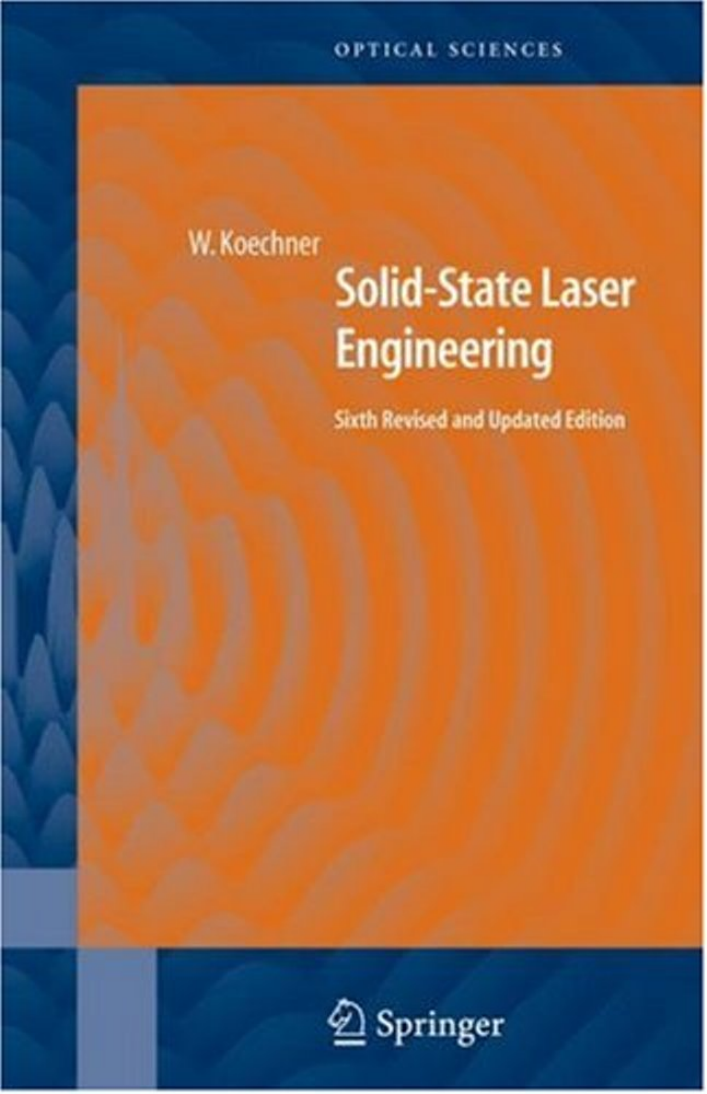
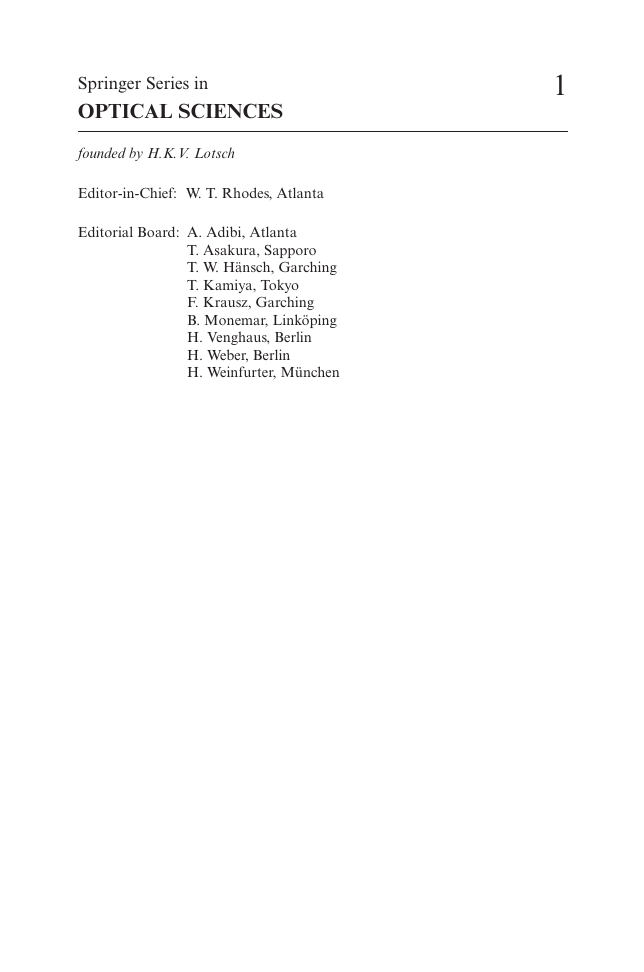
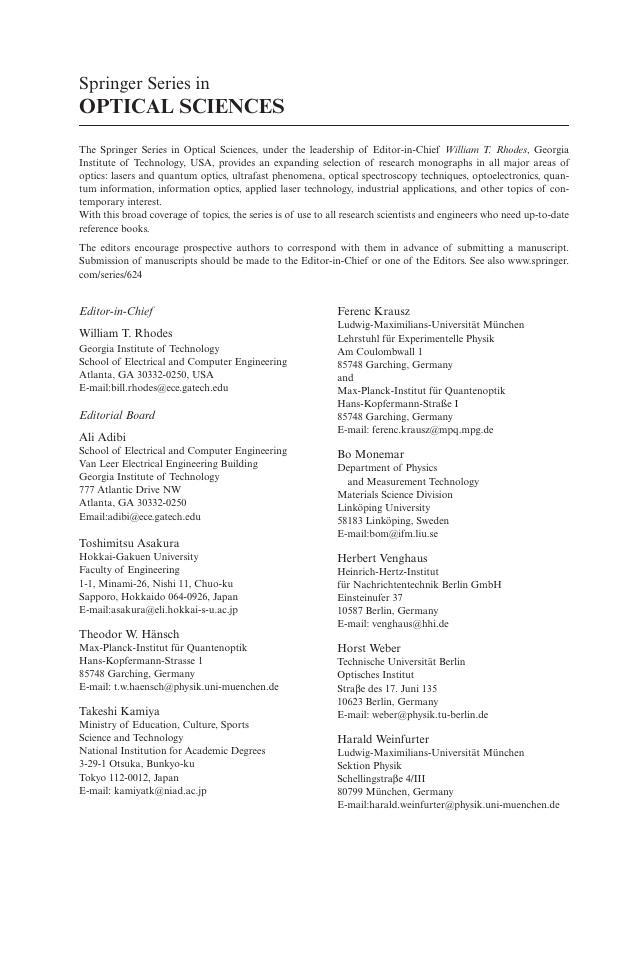



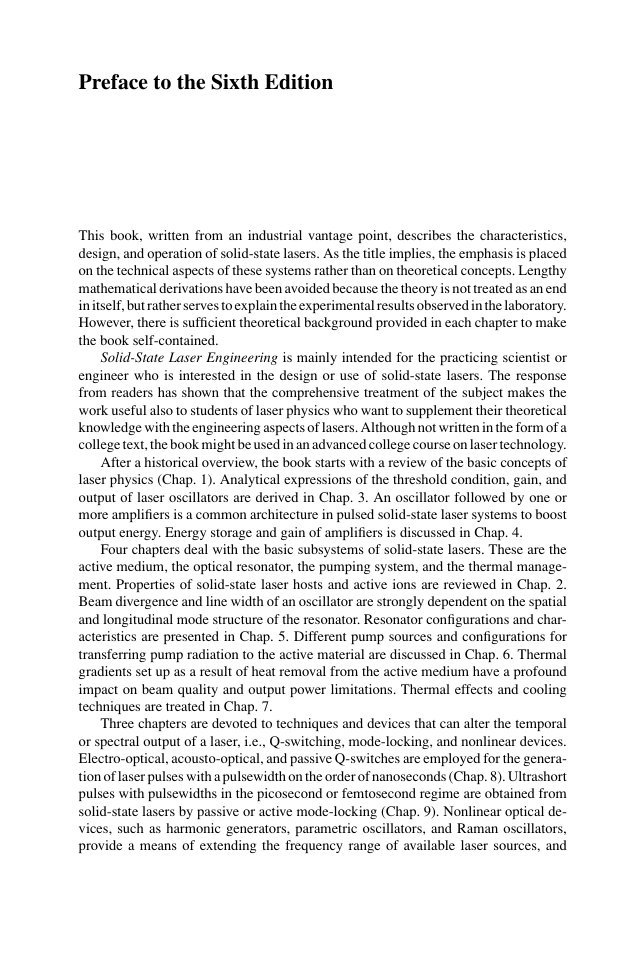
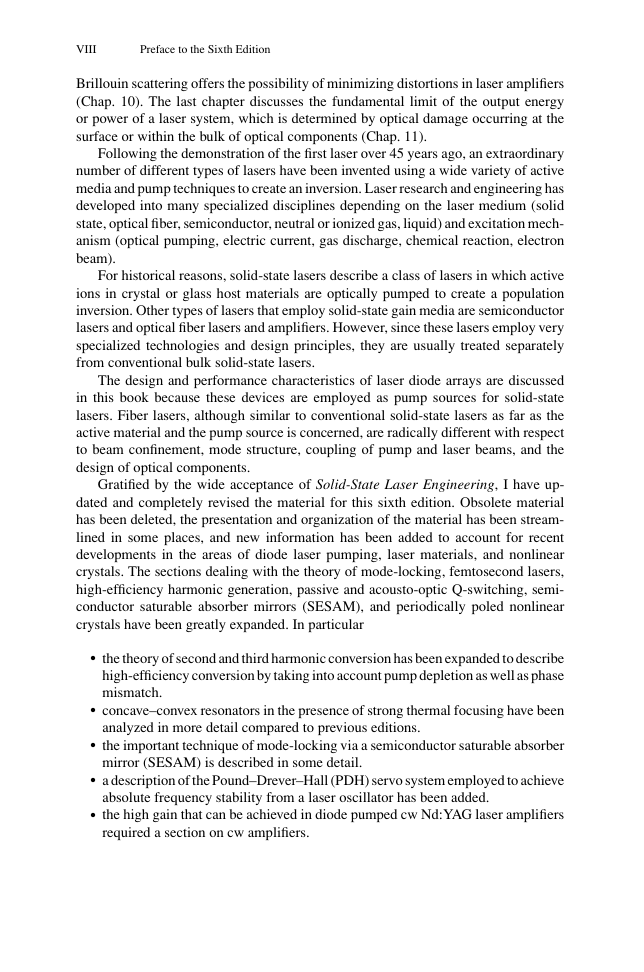








 2023年江西萍乡中考道德与法治真题及答案.doc
2023年江西萍乡中考道德与法治真题及答案.doc 2012年重庆南川中考生物真题及答案.doc
2012年重庆南川中考生物真题及答案.doc 2013年江西师范大学地理学综合及文艺理论基础考研真题.doc
2013年江西师范大学地理学综合及文艺理论基础考研真题.doc 2020年四川甘孜小升初语文真题及答案I卷.doc
2020年四川甘孜小升初语文真题及答案I卷.doc 2020年注册岩土工程师专业基础考试真题及答案.doc
2020年注册岩土工程师专业基础考试真题及答案.doc 2023-2024学年福建省厦门市九年级上学期数学月考试题及答案.doc
2023-2024学年福建省厦门市九年级上学期数学月考试题及答案.doc 2021-2022学年辽宁省沈阳市大东区九年级上学期语文期末试题及答案.doc
2021-2022学年辽宁省沈阳市大东区九年级上学期语文期末试题及答案.doc 2022-2023学年北京东城区初三第一学期物理期末试卷及答案.doc
2022-2023学年北京东城区初三第一学期物理期末试卷及答案.doc 2018上半年江西教师资格初中地理学科知识与教学能力真题及答案.doc
2018上半年江西教师资格初中地理学科知识与教学能力真题及答案.doc 2012年河北国家公务员申论考试真题及答案-省级.doc
2012年河北国家公务员申论考试真题及答案-省级.doc 2020-2021学年江苏省扬州市江都区邵樊片九年级上学期数学第一次质量检测试题及答案.doc
2020-2021学年江苏省扬州市江都区邵樊片九年级上学期数学第一次质量检测试题及答案.doc 2022下半年黑龙江教师资格证中学综合素质真题及答案.doc
2022下半年黑龙江教师资格证中学综合素质真题及答案.doc